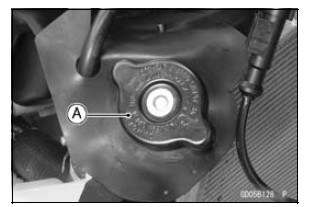

Remove the radiator cap in two steps. First turn the cap counterclockwise to the first stop. Then push and turn it further in the same direction and remove the cap.

NOTE
Wet the cap sealing surfaces with water or coolant to prevent pressure leaks.

NOTICE
During pressure testing, do not exceed the pressure for which the system is designed. The maximum pressure is 142 kPa (1.45 kgf/cm², 21 psi).
If the pressure holds steady, the system is all right.
If the pressure drops and no external source is found, check for internal leaks. Droplets in the engine oil indicate internal leakage. Check the cylinder head gasket and the water pump.
Remove the pressure tester, replenish the coolant, and install the radiator cap.
 Coolant Deterioration Inspection
Coolant Deterioration Inspection Cooling System Flushing
Cooling System FlushingDaily Checks
Check the following items each day before you ride. The time required is
minimal,
and habitual performance of these checks will help ensure you a safe, reliable
ride.
If any irregularities are found during these checks, refer to the Maintenance
and
Adjustment chapter or see your dealer fo ...
Current Mileage
This display mode shows the current
mileage by numerical value. The current
mileage display is renewed every
4 seconds.
A. Current Mileage
B. “km/L”
NOTE
The display unit modes can be
changed, refer to the “Unit Setting”
item in this section.
The numerical value shows “ ...
Throttle Control System
Check the throttle grip play each day
before riding the motorcycle, and carry
out maintenance and adjustments in
accordance with the Periodic Maintenance
Chart. Adjust it if necessary.
Throttle Grip
The throttle grip controls the butterfly
valves in the throttle body. If the throttle
grip ha ...